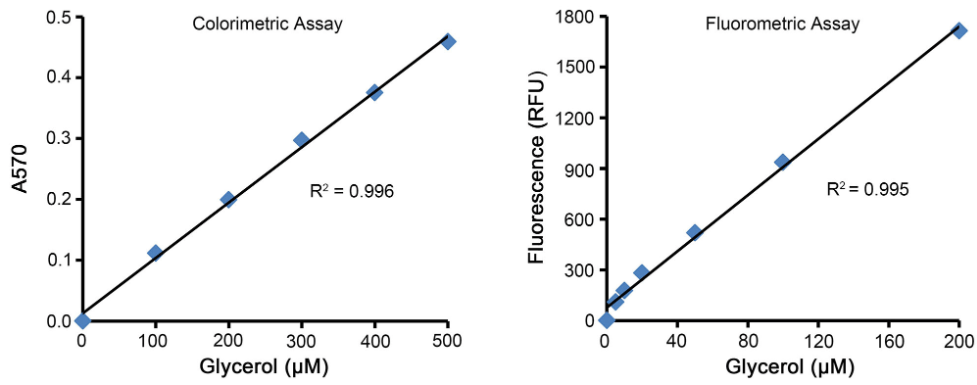
Economical Palm Micro Centrifuge
2025-08-11
Dengue virus type I/II/III/IV Detection Kit (Real-Time PCR Method)
2025-08-22Product Number: ARG-100T
Shipping and Storage
Stored at -20ºC, valid for one year. The Amplex Red and enzyme mixture must be stored away from light.
Component
| Component | ARG-100T |
| Glycerol detection buffer | 15mL |
| Amplex Red | 200μL |
| glycerol kinase | 200μL |
| Enzyme mixture | 200μL |
| Cofactor | 200μL |
| Glycerol standard solution (10mM) | 200μL |
Description
The Amplex Red Glycerol Assay Kit developed by our company is a probe based kit that uses fluorescence or absorbance detection to quickly and sensitively detect the glycerol content in serum, plasma, tissue or cell samples, urine, biological fluids, tissue or cell culture supernatants, and other samples. This kit only detects the content of free glycerol and does not detect the glycerol content in triglycerides.
Glycerol, also known as glycerol or glycerol, is a colorless, odorless, sweet, clear, viscous liquid. The molecular formula of glycerol is C3H8O3, with a molecular weight of 92.09. The chemical structure of glycerol is different from that of carbohydrates and does not belong to the same category of substances. Each gram of glycerol can generate 4 calories when completely oxidized, and glycerol is usually absorbed by the human body without changing blood sugar and insulin levels. Glycerol is a commonly used sweetener and moisturizer in the food processing industry, mostly found in sports food and dairy substitutes. Due to its ability to increase the moisture content in human tissues, glycerol can enhance the body's ability to move in high heat environments. Glycerol is widely used in the production of food, beverages, solvents, drugs, and cosmetics, therefore its quantification is of great significance in research and development.
Glycerol is the main component of triglycerides, the most important storage method for fats, and an important metabolite produced during the oxidation and synthesis processes of energy metabolism. When the human body ingests fat, most of it is emulsified into small particles by bile. Lipases secreted by the pancreas and small intestine hydrolyze the fatty acids in the fat into free fatty acids and monoglycerides. After absorption, monoglycerides and long-chain fatty acids are re synthesized into triglycerides in small intestinal cells. Under physiological conditions, triglycerides are hydrolyzed by lipolysis to produce glycerol and free fatty acids (FFA), which are then released into the bloodstream. The generated glycerol cannot be reabsorbed and utilized by adipose tissue like fatty acids, so the levels of glycerol and free fatty acids in the blood are important indicators for measuring lipolysis levels and are also important indicators in the development of many related drugs.
The Amplex Red in this kit is a highly sensitive fluorescent probe for H2O2. In the presence of horseradish peroxidase (HRP), Amplex Red can react 1:1 with H2O2 to produce a strong red fluorescent substance called Resorufin. The maximum excitation wavelength of the test brine is 571nm, the maximum emission wavelength is 585nm, and there is strong visible light absorption at the excitation wavelength. Therefore, this kit can be tested using both fluorescence and absorbance methods.
The detection principle of this reagent kit is shown in Figure 1. In the presence of ATP, glycerol is phosphorylated by glycerol kinase (GK) to glycerol-3-phosphate. The generated glycerol-3-phosphate then undergoes an oxidation reaction with oxygen gas under the action of glycerol phosphate oxidase (GPO) to produce dihydroxyacetone phosphate (DHAP) and H2O2. The content of glycerol is finally detected by detecting the fluorescence intensity or absorbance of the reaction product of H2O2 and Amplex Red, chlorpromazine. The fluorescence intensity and absorbance of test brine are directly proportional to the content of glycerol in the sample.

Figure 1. Schematic diagram of glycerol assay kit (ARG-100T) for detecting glycerol
This kit provides a standard solution of glycerol, which can be used to calculate the glycerol content in the sample by setting a standard curve. The detection effect of this reagent kit on glycerol standard is shown in Figure 2.

Figure 2. The standard curve for glycerol detection using the Glycerol Assay Kit (ARG-100T). The left image shows absorbance detection, and the right image shows fluorescence detection. The detection data in the figure shows a 60 minute reaction at 37ºC in the dark, and the value may be slightly lower after 30 minutes of reaction. The measured data may vary due to differences in experimental conditions, testing instruments, etc. The data in the figure is for reference only.



